India Becomes Top Sugar Producer As Sugarcane Workers Fall Into Debt Due to Climate Change Destabilizing Farming
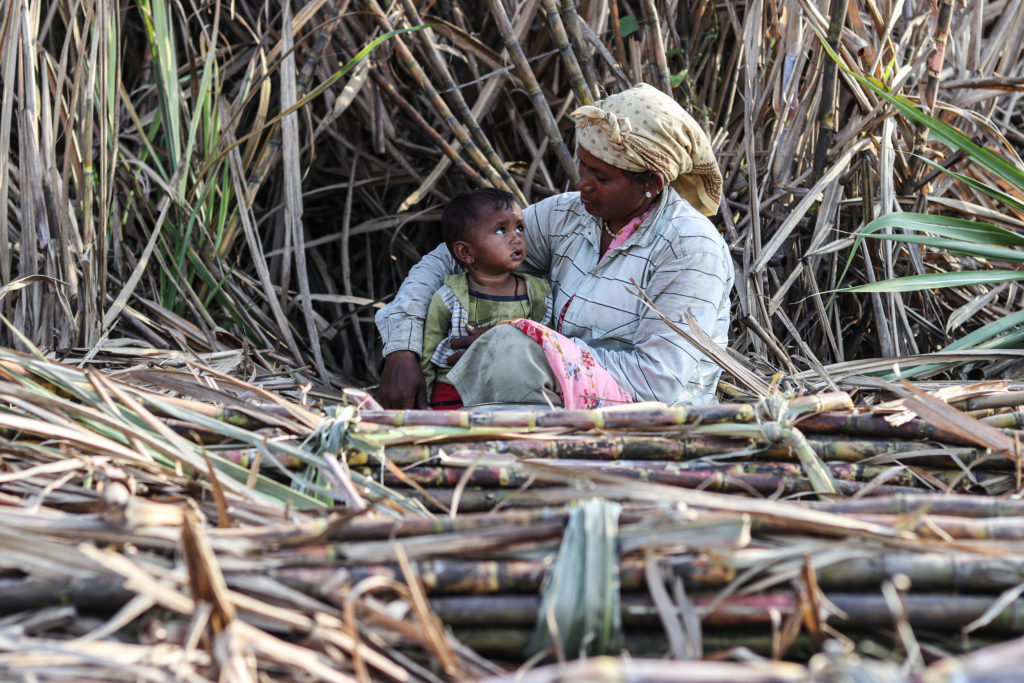
A sugarcane cutter in the fields of western Maharashtra in India looking after her child as she juggles several tasks, often overlooking her own health / credit: Sanket Jain
KHOCHI, India—Anita Bhil regrets taking just a day off after more than two months of work without stop.
Since the first week of October, she has been cutting sugarcane for roughly 12 hours each day using a sickle. She then piles a bundle onto her head to walk over to a tractor. Each bundle of sugarcane weighs 20 kilograms (44 pounds). That’s about the equivalent of a large packed suitcase. By the end of each day, Bhil will have carried 50 bundles on her head and she will have tied together more than 100 bundles of sugarcane stems.
“In the past three years, my body has gotten used to this back-breaking labor,” said Bhil, who’s in her late 20s.
However, October’s devastating rainfall in Khochi village, followed by a sudden drop in temperature, then unusually high temperatures amid winter, caused her to be feverish. She took anti-inflammatory analgesics, returning to work the next day, despite an ailing body.
“Had I not taken a [day] off, I would have cut another 2,000 kilograms (4,410 pounds) of sugarcane,” Bhil said. A landless farm worker from the indigenous Bhil community, she had never before felt the need to migrate from her Chhavadi village in the Dhule district of western India’s Maharashtra state.
However, things have changed since 2018, she said. Incessant rainfall, rapid changes in the local climatic pattern, heat waves, and other recurring climatic events began destroying her region’s farms. For instance, between July and October of this year, natural disasters have affected more than 2.46 million hectares (6 million-plus acres) in Maharashtra alone.
For Bhil, these climate-induced events meant having no choice but to migrate 375 miles to the fields of western Maharashtra to cut sugarcane, moving from one plot to another on any given day. “No one in my family had ever entered this line of work,” she said.
KHOCHI, India—Anita Bhil regrets taking just a day off after more than two months of work without stop.
Since the first week of October, she has been cutting sugarcane for roughly 12 hours each day using a sickle. She then piles a bundle onto her head to walk over to a tractor. Each bundle of sugarcane weighs 20 kilograms (44 pounds). That’s about the equivalent of a large packed suitcase. By the end of each day, Bhil will have carried 50 bundles on her head and she will have tied together more than 100 bundles of sugarcane stems.
“In the past three years, my body has gotten used to this back-breaking labor,” said Bhil, who’s in her late 20s.
However, October’s devastating rainfall in Khochi village, followed by a sudden drop in temperature, then unusually high temperatures amid winter, caused her to be feverish. She took anti-inflammatory analgesics, returning to work the next day, despite an ailing body.
“Had I not taken a [day] off, I would have cut another 2,000 kilograms (4,410 pounds) of sugarcane,” Bhil said. A landless farm worker from the indigenous Bhil community, she had never before felt the need to migrate from her Chhavadi village in the Dhule district of western India’s Maharashtra state.
However, things have changed since 2018, she said. Incessant rainfall, rapid changes in the local climatic pattern, heat waves, and other recurring climatic events began destroying her region’s farms. For instance, between July and October of this year, natural disasters have affected more than 2.46 million hectares (6 million-plus acres) in Maharashtra alone.
For Bhil, these climate-induced events meant having no choice but to migrate 375 miles to the fields of western Maharashtra to cut sugarcane, moving from one plot to another on any given day. “No one in my family had ever entered this line of work,” she said.
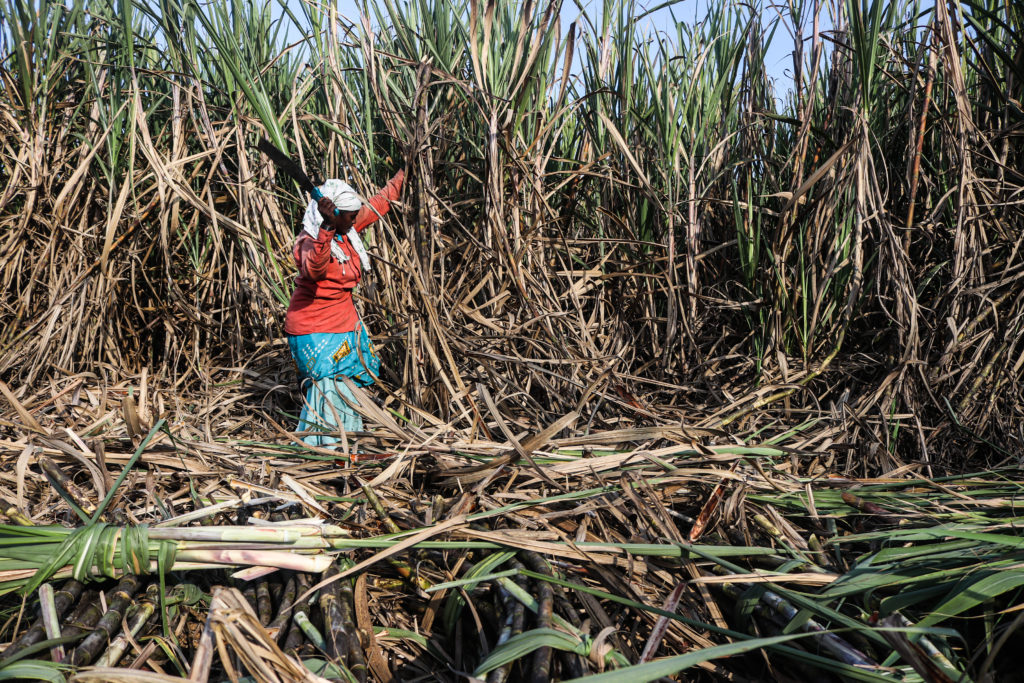
Despite her deteriorating health, sugarcane cutter Anita Bhil refuses to stop working. “If I take a break, it will push me much deeper into poverty,” she said / credit: Sanket Jain
Bonded Labor
In India, the sugar industry impacts the livelihoods of 50 million farmers and their families, who have helped produce more than 500 million metric tons of sugarcane worth 1.18 trillion Indian Rupees ($14.26 billion) from October 2021 to September of this year. That turned India into the largest sugar producer and consumer worldwide in 2021-22. However, producing sweet sugar has come with the bitter taste of labor-law violations, inequality and the perpetuation of the grinding cycle of poverty. In Maharashtra, more than 1 million sugarcane cutters migrate hundreds of miles from their villages, working 15 hours a day for five to six months each year.
With income sources drying up, Bhil and her husband, Kunal, 35, took out a loan of 50,000 Indian Rupees ($615) to pay for each year of their children’s education and meet everyday expenses for up to five months. That meant both had to cut more than 181,000 kilograms (399,036 pounds) of sugarcane in roughly five months, an average of 1.2 tons (2,645 pounds) daily. For cutting 1,000 kilograms of sugarcane, plus tying and loading them onto tractors, these workers in Kolhapur’s Khochi village, where they are working now, are paid $3.40.
Anita has reported a consistent decline in her physical and mental health, which means the amount of sugarcane she has been cutting has been decreasing. She’s been keeping a mental count of every kilogram of sugarcane because last year, by the time the season ended, the couple was 54,000 kilograms short of their target. That is why they returned to the sugarcane fields this year. Yet, every hour lost to a health ailment pushes workers deeper into bonded labor. “I won’t be able to meet this year’s target as well,” Kunal said.
However, what makes sugarcane cutting appear lucrative to poor people is the advance sums.
“It’s a debt trap,” explained Narayan Gaikwad, 75, who has spent more than four decades fighting for the rights of cane cutters, farm workers and daily wage earners. A member of All India Kisan Sabha, the farmers’ wing of the Communist Party of India (Marxist), Gaikwad has unionized hundreds of sugarcane cutters in the Kolhapur district.
“The wages have fallen drastically in the farming sector because of tremendous losses caused by rains and heat waves,” he said.
In the Dhule district, for 10 hours of work, men are paid $1.80, while women earn $1.20. But over in the sugarcane fields of western Maharashtra, workers like Anita and Kunal Bhil are paid $3.40. However, no one can be assured work will be available because of the impact climate change has had on farming. And yet, it’s better than what they faced on their family farm in Chhavadi village.
“When there’s no work in the fields, you are forced to take loans from private money lenders,” Gaikwad explained. “To repay this loan, workers then take loans from sugarcane contractors—it’s a vicious debt cycle.”
On any given day, 49.6 million people around the world are forced into modern slavery, said an International Labour Organization report. The report finds that one-fifth of people involved in forced labor exploitation are in debt bondage, which is most prominent in the mining, agriculture and construction sectors.
“Marginalized communities, ethnic and religious minorities, and indigenous peoples are among the groups at particular risk,” it mentions.
A September 2021 report by Anti-Slavery International and International Institute for Environment and Development issued a warning: “Climate and development policy-makers and planners urgently need to recognize that millions of people displaced by climate change are being, and will be, exposed to slavery in the coming decades.”
Bonded Labor
In India, the sugar industry impacts the livelihoods of 50 million farmers and their families, who have helped produce more than 500 million metric tons of sugarcane worth 1.18 trillion Indian Rupees ($14.26 billion) from October 2021 to September of this year. That turned India into the largest sugar producer and consumer worldwide in 2021-22. However, producing sweet sugar has come with the bitter taste of labor-law violations, inequality and the perpetuation of the grinding cycle of poverty. In Maharashtra, more than 1 million sugarcane cutters migrate hundreds of miles from their villages, working 15 hours a day for five to six months each year.
With income sources drying up, Bhil and her husband, Kunal, 35, took out a loan of 50,000 Indian Rupees ($615) to pay for each year of their children’s education and meet everyday expenses for up to five months. That meant both had to cut more than 181,000 kilograms (399,036 pounds) of sugarcane in roughly five months, an average of 1.2 tons (2,645 pounds) daily. For cutting 1,000 kilograms of sugarcane, plus tying and loading them onto tractors, these workers in Kolhapur’s Khochi village, where they are working now, are paid $3.40.
Anita has reported a consistent decline in her physical and mental health, which means the amount of sugarcane she has been cutting has been decreasing. She’s been keeping a mental count of every kilogram of sugarcane because last year, by the time the season ended, the couple was 54,000 kilograms short of their target. That is why they returned to the sugarcane fields this year. Yet, every hour lost to a health ailment pushes workers deeper into bonded labor. “I won’t be able to meet this year’s target as well,” Kunal said.
However, what makes sugarcane cutting appear lucrative to poor people is the advance sums.
“It’s a debt trap,” explained Narayan Gaikwad, 75, who has spent more than four decades fighting for the rights of cane cutters, farm workers and daily wage earners. A member of All India Kisan Sabha, the farmers’ wing of the Communist Party of India (Marxist), Gaikwad has unionized hundreds of sugarcane cutters in the Kolhapur district.
“The wages have fallen drastically in the farming sector because of tremendous losses caused by rains and heat waves,” he said.
In the Dhule district, for 10 hours of work, men are paid $1.80, while women earn $1.20. But over in the sugarcane fields of western Maharashtra, workers like Anita and Kunal Bhil are paid $3.40. However, no one can be assured work will be available because of the impact climate change has had on farming. And yet, it’s better than what they faced on their family farm in Chhavadi village.
“When there’s no work in the fields, you are forced to take loans from private money lenders,” Gaikwad explained. “To repay this loan, workers then take loans from sugarcane contractors—it’s a vicious debt cycle.”
On any given day, 49.6 million people around the world are forced into modern slavery, said an International Labour Organization report. The report finds that one-fifth of people involved in forced labor exploitation are in debt bondage, which is most prominent in the mining, agriculture and construction sectors.
“Marginalized communities, ethnic and religious minorities, and indigenous peoples are among the groups at particular risk,” it mentions.
A September 2021 report by Anti-Slavery International and International Institute for Environment and Development issued a warning: “Climate and development policy-makers and planners urgently need to recognize that millions of people displaced by climate change are being, and will be, exposed to slavery in the coming decades.”
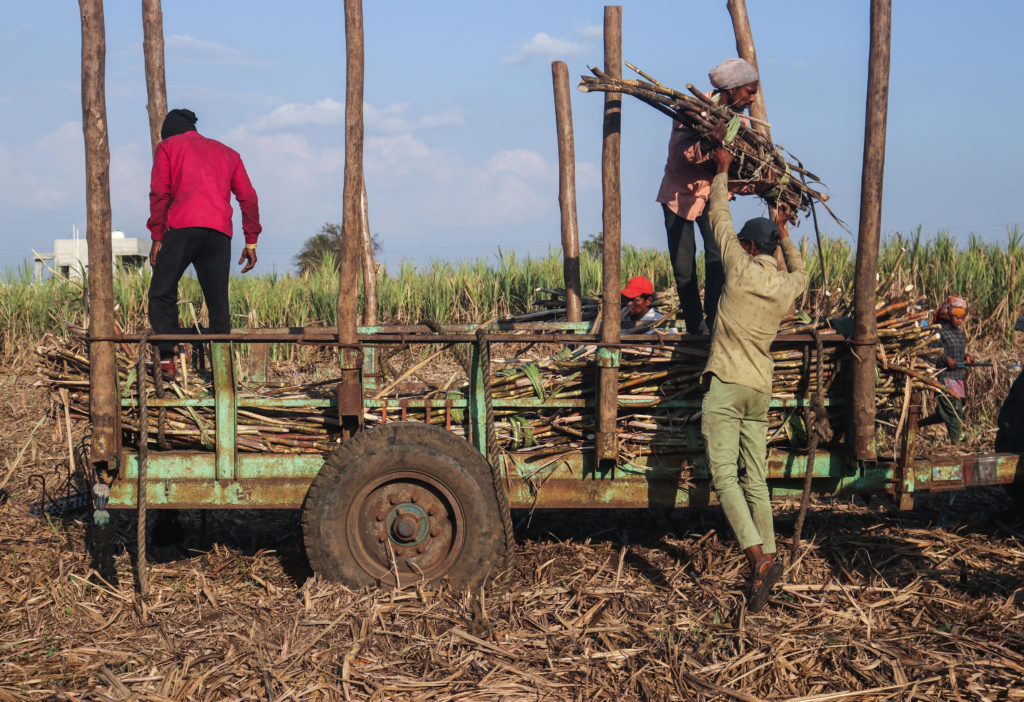
Loading sugarcane on a tractor is risky because the slippery sugarcane fields of western Maharashtra almost lead to imbalance, and many workers have reported fractures in the past / credit: Sanket Jain
Recurring Climate Disasters
Kunal was once proud of the diversity of crops farmers cultivated in his region: Soybean, cotton, maize, sorghum, and others. However, since 2018, it’s become increasingly difficult to see these crops here.
“None of them could survive the changing climate.”
Kunal’s father and two uncles collectively own 16 acres. Last year, on four acres, he cultivated pearl millet and was able to harvest just 17 quintals (3,747 pounds). “I was expecting at least 35-40 quintals.”
As a result, he couldn’t sell a single kilogram and kept the entire harvest for household needs.
The monsoon rains started late in his region. By the time the crop was ready, rainfall was too heavy to allow for harvesting. This was surprising, given Kunal comes from a drought-prone region.
“We always cultivate crops that don’t require much water, but now everything has changed.” When he decided to shift to other crops, the delayed rainfall and the devastating October rains destroyed even this crop.
“We can’t decide what to grow because of the fluctuating climate.” Moreover, the losses aren’t restricted to the farming fields. Of his three daughters, Kunal brought two of them to the sugarcane fields. “Who will take care of children back in the village when everyone migrates?” he asks.
Kunal, who became a helping hand too early in his life, couldn’t go to school. “I never wanted this to happen to my children, but looking at the climate disasters, I think even they will have to do this work.”
Recurring Climate Disasters
Kunal was once proud of the diversity of crops farmers cultivated in his region: Soybean, cotton, maize, sorghum, and others. However, since 2018, it’s become increasingly difficult to see these crops here.
“None of them could survive the changing climate.”
Kunal’s father and two uncles collectively own 16 acres. Last year, on four acres, he cultivated pearl millet and was able to harvest just 17 quintals (3,747 pounds). “I was expecting at least 35-40 quintals.”
As a result, he couldn’t sell a single kilogram and kept the entire harvest for household needs.
The monsoon rains started late in his region. By the time the crop was ready, rainfall was too heavy to allow for harvesting. This was surprising, given Kunal comes from a drought-prone region.
“We always cultivate crops that don’t require much water, but now everything has changed.” When he decided to shift to other crops, the delayed rainfall and the devastating October rains destroyed even this crop.
“We can’t decide what to grow because of the fluctuating climate.” Moreover, the losses aren’t restricted to the farming fields. Of his three daughters, Kunal brought two of them to the sugarcane fields. “Who will take care of children back in the village when everyone migrates?” he asks.
Kunal, who became a helping hand too early in his life, couldn’t go to school. “I never wanted this to happen to my children, but looking at the climate disasters, I think even they will have to do this work.”
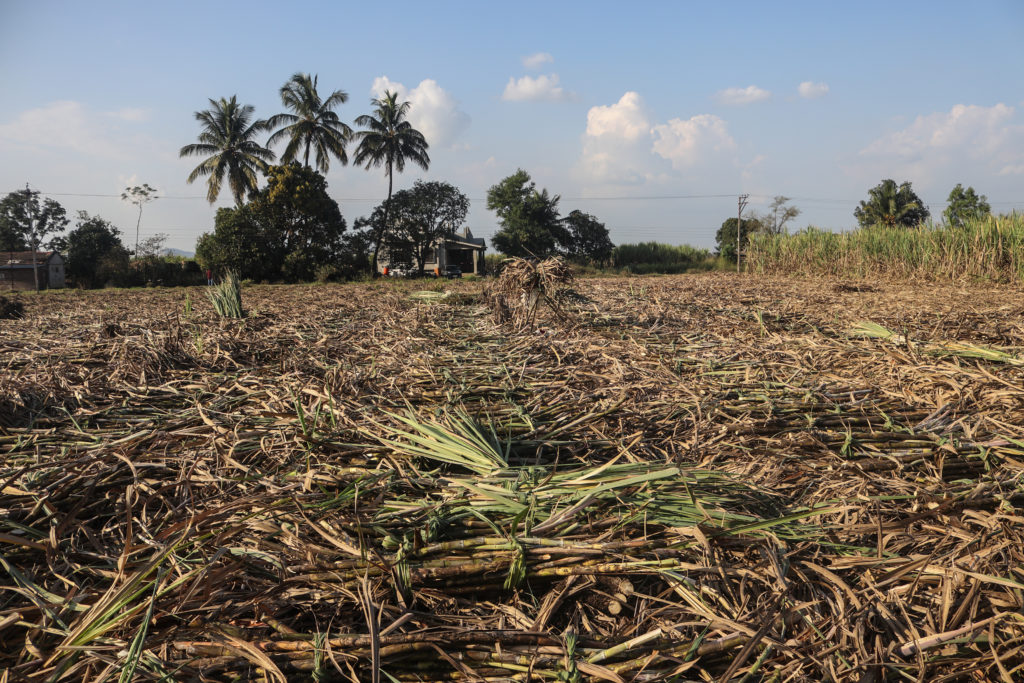
Every year, more than 1 million farm workers migrate hundreds of miles from Maharashtra’s farming villages to the fields of western Maharashtra to cut sugarcane / credit: Sanket Jain
Paying for the Sins of the Global North
Between 1991 and 2001, climate disasters led to 676,000 deaths and affected an average of 189 million people living in developing countries every year, according to the Loss and Damage Collaboration’s report. “In the first half of 2022, six fossil fuel companies made enough to cover the costs of extreme climate- and weather-related events in all developing countries and still have nearly $70 billion left over in pure profit.”
Loss and Damage refer to the economic and non-economic impacts of climate change that cannot be avoided through mitigation or adaptation. Oxfam’s report said the estimated cost of Loss and Damage can range from $290 billion to $580 billion. Research published in Lancet found that from 1850 to 2015, the Global North was responsible for 92 percent of excess emissions, the United States 40 percent and the European Union 29 percent.
In 1991, Vanuatu, an island country in the south Pacific Ocean, first proposed on behalf of the Alliance of Small Island States (AOSIS) compensation for the impacts of rising sea levels due to climate change. It took 31 years for the issue to be addressed at a COP.
The 2022 United Nations Climate Change Conference (COP27), held last month in Sharm El-Sheikh, Egypt, ended with an agreement to establish a Loss and Damage fund.
However, several details, such as its operation and which countries would contribute to this fund, haven’t been finalized. The negotiations ended with an agreement to establish a “transitional committee,” which would make recommendations on operationalizing the funding and adopting it at the next COP.
To top it off, no agreement remains about what counts as Loss and Damage. Meanwhile, thousands of workers like Anita Bhil are being pushed every day into bonded labor.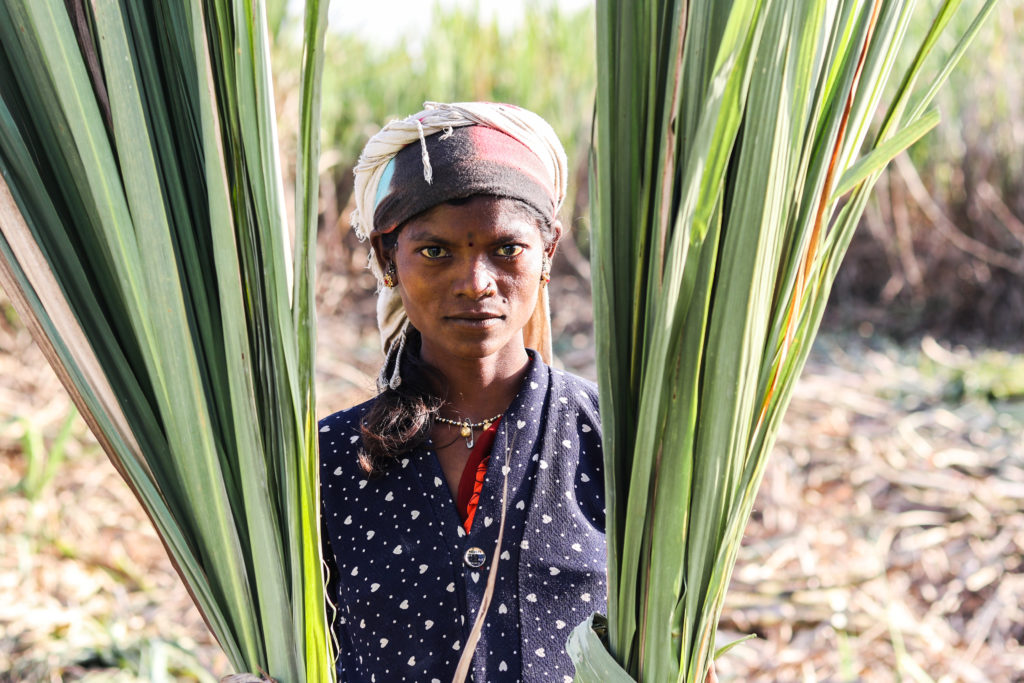 Sugarcane cutter Sarla Bhil said she started migrating to sugarcane fields for work only three years ago because of recurring climate disasters, which are devastating crops in her region / credit: Sanket Jain
Sugarcane cutter Sarla Bhil said she started migrating to sugarcane fields for work only three years ago because of recurring climate disasters, which are devastating crops in her region / credit: Sanket Jain
‘No Option But to Migrate’
After cutting cane for more than two months this year, Prakash Bhil, 32, said he made a firm decision.
“No matter what, I won’t return next year to cut sugarcane.” He paused for a few moments and said, “But…” Then he stopped again. Almost teary-eyed, he placed his hand on the right leg. He thought it might be fractured, but he couldn’t visit a doctor because of the workload. “But it all depends if I will be able to cut enough sugarcane this year and whether rains create any havoc in my village,” Bhil said. “I just hope my children get a good education.”
Last year, the fields where he worked saw devastating rains, washing away cotton, soybean and sorghum. “Nothing survived.” Earlier, he found work for at least 25 days a month. “Now even finding 15 days of work is becoming difficult,” he said, referring to the impact of incessant rainfall.
Unable to pay off a $74 loan from last year, he returned to the sugarcane fields. “This year, I took an advance of $245 and won’t be able to repay it because of my poor health.” While he’s resting, the entire burden has fallen on his wife, a frail Sarla in her early 20s.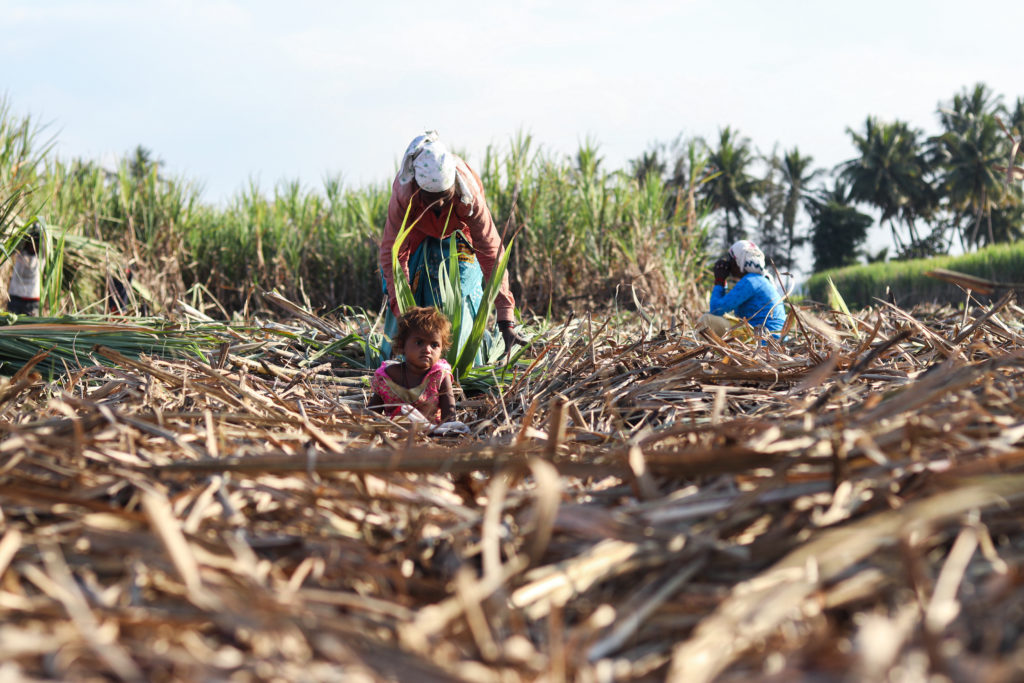
Paying for the Sins of the Global North
Between 1991 and 2001, climate disasters led to 676,000 deaths and affected an average of 189 million people living in developing countries every year, according to the Loss and Damage Collaboration’s report. “In the first half of 2022, six fossil fuel companies made enough to cover the costs of extreme climate- and weather-related events in all developing countries and still have nearly $70 billion left over in pure profit.”
Loss and Damage refer to the economic and non-economic impacts of climate change that cannot be avoided through mitigation or adaptation. Oxfam’s report said the estimated cost of Loss and Damage can range from $290 billion to $580 billion. Research published in Lancet found that from 1850 to 2015, the Global North was responsible for 92 percent of excess emissions, the United States 40 percent and the European Union 29 percent.
In 1991, Vanuatu, an island country in the south Pacific Ocean, first proposed on behalf of the Alliance of Small Island States (AOSIS) compensation for the impacts of rising sea levels due to climate change. It took 31 years for the issue to be addressed at a COP.
The 2022 United Nations Climate Change Conference (COP27), held last month in Sharm El-Sheikh, Egypt, ended with an agreement to establish a Loss and Damage fund.
However, several details, such as its operation and which countries would contribute to this fund, haven’t been finalized. The negotiations ended with an agreement to establish a “transitional committee,” which would make recommendations on operationalizing the funding and adopting it at the next COP.
To top it off, no agreement remains about what counts as Loss and Damage. Meanwhile, thousands of workers like Anita Bhil are being pushed every day into bonded labor.
 Sugarcane cutter Sarla Bhil said she started migrating to sugarcane fields for work only three years ago because of recurring climate disasters, which are devastating crops in her region / credit: Sanket Jain
Sugarcane cutter Sarla Bhil said she started migrating to sugarcane fields for work only three years ago because of recurring climate disasters, which are devastating crops in her region / credit: Sanket Jain‘No Option But to Migrate’
After cutting cane for more than two months this year, Prakash Bhil, 32, said he made a firm decision.
“No matter what, I won’t return next year to cut sugarcane.” He paused for a few moments and said, “But…” Then he stopped again. Almost teary-eyed, he placed his hand on the right leg. He thought it might be fractured, but he couldn’t visit a doctor because of the workload. “But it all depends if I will be able to cut enough sugarcane this year and whether rains create any havoc in my village,” Bhil said. “I just hope my children get a good education.”
Last year, the fields where he worked saw devastating rains, washing away cotton, soybean and sorghum. “Nothing survived.” Earlier, he found work for at least 25 days a month. “Now even finding 15 days of work is becoming difficult,” he said, referring to the impact of incessant rainfall.
Unable to pay off a $74 loan from last year, he returned to the sugarcane fields. “This year, I took an advance of $245 and won’t be able to repay it because of my poor health.” While he’s resting, the entire burden has fallen on his wife, a frail Sarla in her early 20s.

Anita Bhil brought her infant daughter to the sugarcane fields because no one was available back home to provide childcare / credit: Sanket Jain
Back to Work 3 Days After Giving Birth
“There are massive labor rights violations in the production of sugar,” said Narayan, the organizer. He then shared the story of a sugarcane cutter who had migrated to the Kolhapur district. She was 9 months and 9 days pregnant.
“She was cutting sugarcane for seven hours and started experiencing labor pains in the evening. The case was so complicated that three public hospitals rejected her.” Narayan then took her to the district hospital and ensured a safe childbirth. “After three days, she was back to cutting cane,” Narayan added. “A decade since then, nothing much has changed.”
For more than seven years, community healthcare worker Shubhangi Kamble in Maharashtra’s Arjunwad village has been helping make public healthcare accessible to sugarcane cutters by going door to door, providing healthcare on the spot and connecting workers with doctors and hospitals. She said the cutters’ situation has been getting worse every year, attributing it to declining incomes caused by climate change impacts.
“Sugarcane cutters are trapped in debt, and no matter what happens to their health, they don’t take a break. Many do not even complete their prescribed medical course because they can’t afford the costly medicines,” she shared. In the past three years, complaints of body aches, fatigue, and dizziness have increased among cane cutters, especially among women, according to Kamble.
One among them is Anita Bhil, who, despite her deteriorating health, is adamant about not taking a break.
“A day’s off can push an entire generation into poverty,” Bhil said, as thuds of chopping sugarcane reverberated throughout the fields.
Back to Work 3 Days After Giving Birth
“There are massive labor rights violations in the production of sugar,” said Narayan, the organizer. He then shared the story of a sugarcane cutter who had migrated to the Kolhapur district. She was 9 months and 9 days pregnant.
“She was cutting sugarcane for seven hours and started experiencing labor pains in the evening. The case was so complicated that three public hospitals rejected her.” Narayan then took her to the district hospital and ensured a safe childbirth. “After three days, she was back to cutting cane,” Narayan added. “A decade since then, nothing much has changed.”
For more than seven years, community healthcare worker Shubhangi Kamble in Maharashtra’s Arjunwad village has been helping make public healthcare accessible to sugarcane cutters by going door to door, providing healthcare on the spot and connecting workers with doctors and hospitals. She said the cutters’ situation has been getting worse every year, attributing it to declining incomes caused by climate change impacts.
“Sugarcane cutters are trapped in debt, and no matter what happens to their health, they don’t take a break. Many do not even complete their prescribed medical course because they can’t afford the costly medicines,” she shared. In the past three years, complaints of body aches, fatigue, and dizziness have increased among cane cutters, especially among women, according to Kamble.
One among them is Anita Bhil, who, despite her deteriorating health, is adamant about not taking a break.
“A day’s off can push an entire generation into poverty,” Bhil said, as thuds of chopping sugarcane reverberated throughout the fields.
Sanket Jain is an independent journalist based in the Kolhapur district of the western Indian state of Maharashtra. He was a 2019 People’s Archive of Rural India fellow, for which he documented vanishing art forms in the Indian countryside. He has written for Baffler, Progressive Magazine, Counterpunch, Byline Times, The National, Popula, Media Co-op, Indian Express and several other publications.

No comments:
Post a Comment